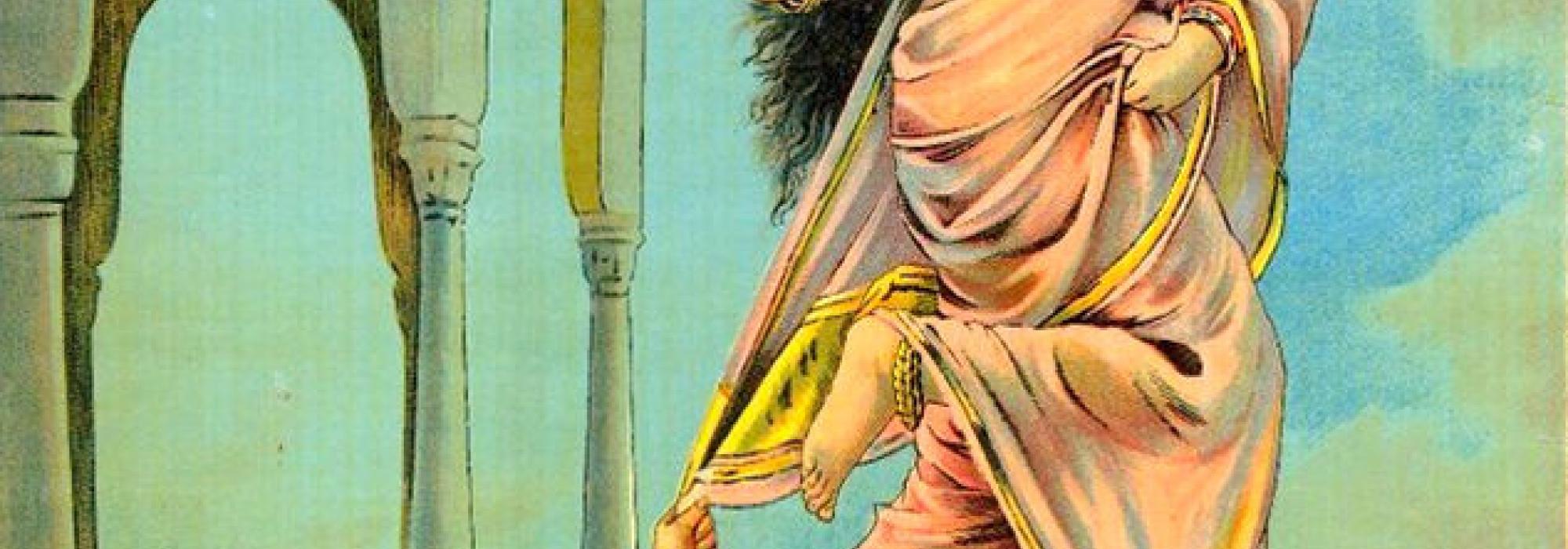The Vikramorvaśīyam, like the Mālavikāgnimitram consists of five acts. The following the summary of its plot
King Purūrava, who was returning after having finished his sūryopāsana, hears that a rākṣasa named Keśi had abducted the apsarā Urvaśī and her friend Citralekhā. He immediately heads to rescue them and is successful in his endeavour. The apsarās reunite in the Hemakūṭa Mountain and go back to devaloka, accompanied by a gandharva named Citraratha, who was sent by Devendra. Urvaśī and Purūrava fall in love with each other.
The king craves for Urvaśī’s company while in his garden. The apsarā comes there with her friend Citralekhā; they remain invisible and watch Purūrava pine for her. Urvaśī writes a love letter on a bhūrja-patra – leaf of the birch tree; she also lets her heart known to the king through Citralekhā and finally appears before him. There is excitement and joy in the air. Urvaśī gets a sudden call from Indra and a divine messenger comes to escort her for a dance-drama performance. Both Purūrava and Urvaśī are pained due to this sudden separation. By now, the king’s feelings for Urvaśī had fallen upon the ears of the chief queen – this was due to the recklessness of the vidūṣaka as well as the smartness of Nipuṇikā. She comes searching for Purūrava in the garden and to add to his misfortunes, the love letter written by Urvaśī gets carried by wind and falls into the hands of the chief queen; this confirms her suspicion about her husband. Purūrava is taken by surprise by the sudden appearance of his queen. He begs for her pardon and requests her to accept his new romantic endeavour. The queen does not agree and goes away annoyed.
Back in the svarga, the Lakṣmī-svayaṃvara nāṭaka was being staged and Urvaśī had donned the role of Devī Lakṣmī. As a part of the play, the sakhī asks Lakṣmī who she would like to marry. Urvaśī, who was supposed to say that she desires to marry Puruṣottama, i.e., Viṣṇu, says Purūrava instead – a slip of tongue and a revelation of her heart. Looking at this, the nāṭyācārya Bharata-muni gets angry and curses her to go away from the devaloka. Indra, who feels sorry for her provides an antidote to the curse – he says that she can return to her abode in svarga after she gives birth to a son through her beloved Purūrava; this delimits her time on earth. Urvaśī comes back to Purūrava’s palace with her sakhī Citralekhā and lands upon the gem-decked terrace. Incidentally, the king was on his terrace as per the wishes of his queen – he had come there to witness the union[1] of the star Rohiṇī and Candra, i.e., the Moon. Urvaśī, who was invisible to the king until then wanted to give up her tiraskariṇī and become visible to him; by the time she does that, the queen comes there with articles for pūjā. The ritual was only a pretext for the queen to overcome the bitterness that had suddenly developed between her and her husband Purūrava; she had taken up the priya-prasādana-vrata[2] in reality. The king was happy and balanced. The queen too performs the ritual of Candra-pūjā and displays her fondness towards her husband; she says that he may go ahead in his romantic affair with newly found love. The next moment, Urvaśī appears behind the king and closes his eyes with her hands. He recognises her with her touch and then she comes and stands before him.
The king hands over the responsibility of the governance of his kingdom to his minister and enjoys happy moments with Urvaśī on the Mt. Gandhamādana. Once, when they were sporting on the banks of the river Gaṅgā, Urvaśī notices him eying a vidyādharī; she grows angry with him, enters the Kumāra-vana and turns into a creeper there – this was because of a curse that Kumāra-svāmī had pronounced in the past – any woman who entered the garden was to turn into a creeper. King Purūrava learns this, looks for Urvaśī everywhere and starts asking animals and birds, like a madman. He begs them to reveal his beloved to him. He happens to come upon the saṅgamanīya-maṇi there; he picks it up and still craving for his beloved, hugs a creeper, which was actually Urvaśī. Thanks to the influence of the divine gem, the apsarā regains her original form. This brings an end to their romantic roaming and he returns to his kingdom. The saṅgamanīya-maṇi becomes Urvaśī’s cūḍāmaṇi.
To be continued ...
The current series of articles is an enlarged adaption of Prof. A. R. Krishnasastri's Kannada treatise Saṃskṛta-nāṭaka. They are presented along with additional information and footnotes by Arjun Bharadwaj.
[1] rohiṇī-candra-samāgamotsava
[2] A ritualistic observance that is thought to resolve misunderstandings between the husband and the wife










































